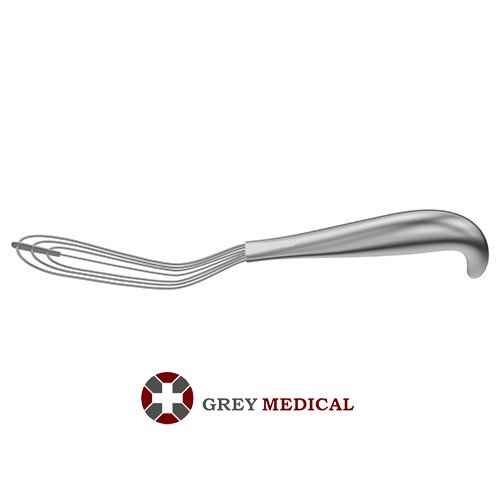When it comes to life-saving procedures, precision and the right tools are crucial. The surgical rib spreader, often overlooked outside medical circles, stands at the forefront of critical instruments used in thoracic surgeries. Its significance in ensuring successful operations cannot be overstated, offering access to the body's vital areas while minimising tissue damage. Let's explore in detail what makes this tool indispensable in healthcare.
What Is a Surgical Rib Spreader?
A surgical rib spreader also referred to in medical terminology as a rib retractor, is a specialised instrument used to separate the ribs during surgical procedures. Typically made of stainless steel for durability and sterility, this instrument is designed with two flat blades connected to a central mechanism. The mechanism functions as both a handle and a device to control the blades' movement, providing the surgeon with an adjustable, controlled opening of the ribcage.
By creating space between the ribs, the surgical rib spreader allows surgeons to access internal organs like the heart, lungs, and blood vessels. This controlled separation is critical in procedures such as open-heart surgery, lung resections, and trauma repair.
Purpose and Functionality
The primary purpose of a surgical rib spreader is to facilitate safe and efficient access to the thoracic cavity. Without this instrument, performing intricate surgeries on internal organs would be not only challenging but often impossible. Surgeons rely on its mechanical efficiency to avoid exerting undue pressure on the ribs while maintaining a clear field of vision and freedom of movement during the procedure.
Once the ribs are separated, the surgeon can operate within a stabilised space, reducing the risk of accidental damage to surrounding tissues. This level of precision is particularly crucial in high-stakes environments such as cardiac surgeries, where every millimetre matters.
The mechanism of the rib spreader is surprisingly simple yet effective. By turning a central screw or gearing system, the blades expand outward, gradually pushing the ribs apart. This controlled separation helps avoid fractures or excessive strain, ensuring the patient’s safety during the operation.
Importance in Surgical Procedures
The significance of the surgical rib spreader becomes apparent when considering the complexities of thoracic surgery. Whether addressing trauma, cardiovascular diseases, or pulmonary conditions, this instrument plays a vital role in saving lives.
For instance, in open-heart surgery, the rib spreader provides the surgeon with the access needed to perform intricate tasks such as valve replacements or coronary artery bypass grafting. The tool ensures the chest remains stable and open throughout the operation, allowing for greater precision and reducing the surgery's overall duration.
Additionally, trauma care frequently involves the use of rib spreaders. When a patient arrives with severe chest injuries preventing normal respiration or circulation, surgeons must employ rapid, effective measures. A rib spreader grants immediate access to the problem area, facilitating life-saving interventions like haemothorax repair or vessel reconstruction.
The Role of the Rib Spreader in Modern Advancements
The evolution of surgical techniques has highlighted the rib spreader’s adaptability to modern technologies. Minimally invasive procedures, which aim to reduce patient recovery time and improve outcomes, still depend on the reliability of this functional tool.
Innovations in rib spreader designs have also kept pace with these advancements. Today, options include lightweight materials to reduce the surgeon's fatigue, ergonomic handles for better control, and radiolucent designs that allow imaging equipment to scan through the tool without interference. Surgeons can now use these improved instruments alongside robotic systems or high-definition cameras, creating a synergy between tradition and cutting-edge innovation.
One particularly notable advancement is the development of paediatric rib spreaders, catering to the unique needs of children undergoing thoracic surgeries. These smaller, more delicate designs reflect the instrument's versatility and its centrality in advancing patient care across all demographics.
Conclusion
The surgical rib spreader holds an irreplaceable position in the operating theatre, bridging the gap between inaccessible internal cavities and the life-saving procedures they require. Despite its utilitarian design, it is a marvel of engineering, facilitating delicate procedures that demand utmost precision.
Beyond its mechanical role, the rib spreader embodies the progress of medical science. Its design has continuously evolved to align with advancements in surgical methods, ensuring it remains relevant in addressing modern healthcare challenges. It is a tool of necessity, but one that carries the profound responsibility of helping to save countless lives.
By improving patient outcomes and aiding surgeons in some of the most complex procedures, the surgical rib spreader stands as a testament to the essential role of medical instruments. It may not be the most recognisable tool outside the hospital setting, but within the operating theatre, it is nothing short of indispensable. The next time we consider the marvels of modern medicine, this unassuming instrument deserves its due recognition.





Comments